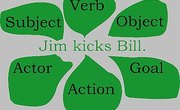The agreement of a subject and verb in a sentence is important for clarity of meaning. In English there are singular and plural nouns and pronouns and singular and plural forms of verbs. A singular subject must be paired with a singular form of a verb, and a plural must be paired with a plural. Usually this is straightforward, but some difficulties arise when it's difficult to identify the subject or when the subject is complex.
Identifying the Verb
The first step to assuring correct subject-verb agreement is to identify the verb or verbs in a sentence. A verb is either an action word or a word that shows existence or a state of being. Action verbs are easy to identify. In the sentence, "The boy runs to school every day," the action is easily identified as "runs." However, actions need not be physical. "The boy dreams all night long." The action in this sentence is "dreams." Even though it's a mental action, the word "dreams" is still an action verb.
State of being verbs can be memorized. They are: "am, is, are, was, were, be, being, been" and the verbs "grow, seem, remain, taste, smell, feel" when they are used as linking rather than action verbs.
In the sentence, "The apple tastes sweet," "tastes" is a linking verb. In the sentence, "I taste the sweetness in the apple," "taste" is an action verb.
Identifying the Subject
Once the verb in a sentence is identified, it's easy to locate the subject by asking "Who or What + verb?" In the example sentence, "The boy runs to school," the verb is "runs." Ask "Who or What runs?" The answer is "The boy." Take away the modifiers and the simple subject of the sentence is "boy."
Singular Subjects and Singular Verbs
If the subject is singular -- only one entity -- the verb form must also be singular. If the subject is "boy," the verb must be "runs." Most of the time, if you put the subject and verb together, you can "hear" what is correct. "The boy run to school" should not "sound" right. Be careful when there are prepositional phrases involved. Often this can make it difficult to identify the subject. "The boy with the large pile of books runs to school." The subject is still "boy," not "books."
A tricky situation involves collective nouns. These are nouns that refer to individual items all at once -- such as "class." Even though there is more than one person in a class, all together they form one group so "class" is considered singular: "The class learns about grammar."
Plural Subjects and Plural Verbs
Plural subjects usually end in "s." "The boys run to school." But subjects connected by commas or "and" are also plural: "The boy and girl run to school." "The boy, his brother and his sister run to school." But subjects connected by "along with" or "as well as" are still singular: "The boy, along with his sister, runs to school." Although grammatically correct, this is an awkward construction and should be re-written for clearer meaning. There are also plural nouns that don't end in "s," such as, "The children eat cookies."
Indefinite Pronouns
The most difficult subject-verb agreement issues arise when indefinite pronouns are the subject. The following are always singular: each, anyone, everyone, someone, no one, nobody. The problem is they don't "sound" singular. "Everyone takes a break at noon." Even though the subject refers to a group of people, the word itself is singular. "Each of the girls eats alone." The subject here is not "girls," but "each," which is singular.
Related Articles
References
Resources
Writer Bio
Diane Kampf has more than 20 years of teaching experience ranging from middle school to college freshmen. She holds a Master of Arts degree in creative writing and English literature and a New York State Secondary Teacher Certificate. She has written educational materials for Learning Express, LLC, Kaplan and Pearson.











